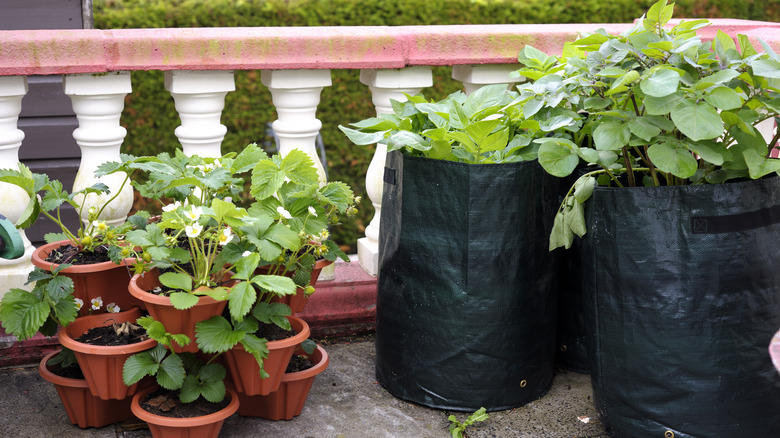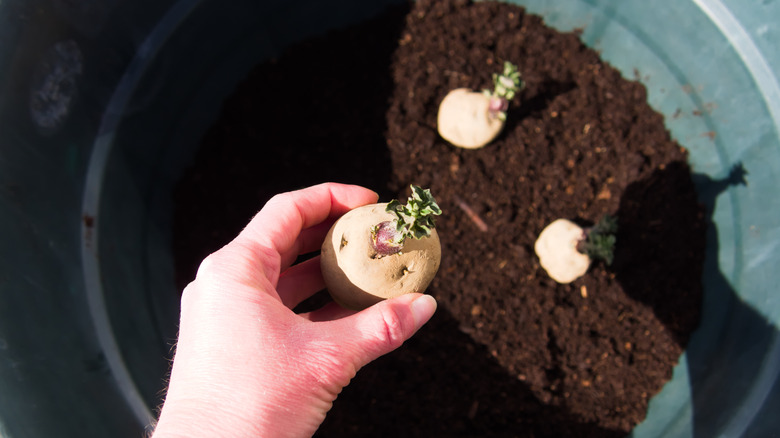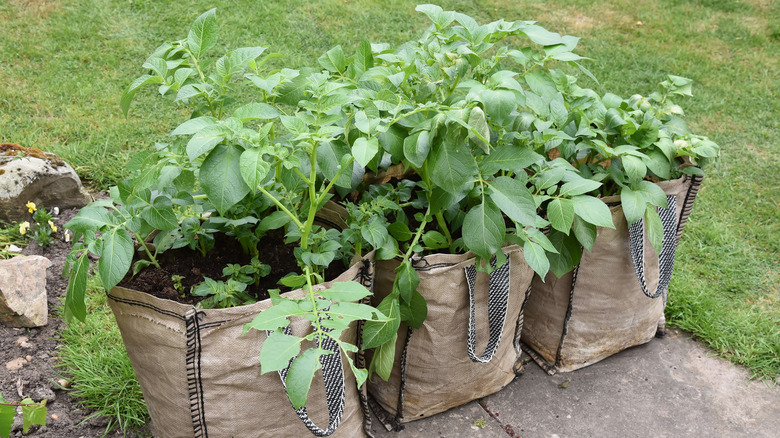How To Grow Delicious Potatoes In Containers For A Fresh And Easy Harvest
Potatoes seem like one of those things farmers have a monopoly on, but you can certainly grow them in your backyard garden or even on your balcony. They're surprisingly easy to grow in a container. Conveniently, you don't need to start with deep soil since new potatoes will grow above the seed potato, so as long as you can build up the soil as needed, you can start in a pretty shallow container. You don't even need a "respectable" container — you can use a laundry basket to grow potatoes in and still end up with a decent crop.
Before planting, be sure to buy your seed potatoes from a reputable company; the ones from grocery stores could have been sprayed with growth inhibitors to prevent them from sprouting. They may also carry diseases that will infect future crops, so if they do happen to sprout, they may not be healthy. Small seed potatoes can be planted whole, but larger ones should be cut into smaller pieces and left to dry out a bit before planting. Planting cut potatoes while the exposed portion is still moist could lead to rotting underground, and they won't sprout.
Make sure the space is just right
Just as a potato farmer takes great care to ensure their field is perfect for their crop, you should put the effort into finding the right container. Theoretically, you can grow potatoes in almost anything, but for an easy, harvestable crop, you must ensure the container will fit the amount of potatoes, maintain proper moisture, and be easy to work with. Every potato you plant will need about 5 gallons of soil. You only need 6 inches of soil beneath the seed potato, but you'll need to add soil on top as they grow. The container should be at least 2 feet deep for enough vertical space. If you want to grow more than one plant per container, seed potatoes should be 1 foot apart from each other. For larger container crops, you can reuse a kiddie pool to make sure every plant has enough room to stretch out.
It's important that you don't choose a planter that will hold too much moisture, as it could cause the potatoes to turn soggy if they stay wet too long. Drainage holes are a must when growing potatoes. Cloth grow bags work well because they easily drain water. Once you're sure your container has proper drainage, you'll also have to gauge if you are providing the soil with enough moisture. Containers dry out quicker than the ground, so you may need to water daily in the summer.
Provide the right nutrients, sunlight, and water
Growing potatoes is easy, but you do need to avoid the gardening mistakes everyone makes when growing potatoes. Otherwise, you'll end up with a disappointing harvest. Even though they grow underground, the leafy portion needs full sun exposure, which is at least six hours of direct sunlight. There should only be 3 to 6 inches of leaves exposed at a time, so be sure to continue hilling your potatoes as they grow to keep the tubers covered. Tubers exposed to sunlight will turn green and toxic — don't eat those!
Water your potatoes when the top 1 or 2 inches of soil are dry. Continue watering as the plant grows, but once the leaves turn yellow and start to die back, stop watering so the potatoes can dry out for a couple of weeks before it's time to harvest. Don't wash dirt off the potatoes you want to store, as those need to stay dry for a longer shelf life.
Potatoes are hungry plants and should be regularly fertilized as they grow. Organic fertilizer should be applied at least once a month, while synthetic fertilizers can be applied every couple of weeks. Opt for a fertilizer with an NPK of 5-10-10, as too much nitrogen will force the plant to focus on producing more foliage rather than tubers.


